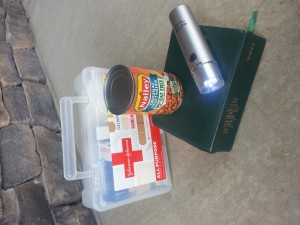Prophets have counseled members of The Church of Jesus Christ of Latter-day Saints for decades to be prepared and have a plan in case of a natural or personal disaster.
Many families in the Church have taken this counsel to heart and have put together emergency preparedness plans, along with 72-hour kits and a year’s worth of food storage.

Often, however, college students are challenged in finding a good balance of how they can be prepared themselves. Many do not have the means or space to buy and store a personal, six-month food supply, but there are things students can do on a smaller scale to prepare themselves for when a disaster strikes.
Art Johnson, a freshman from St. George, grew up in a home where emergency preparedness was a priority. His parents not only taught the importance of being prepared as a family but also how to be prepared as individuals.
“I keep a case of chili and a box of Snickers bars on my shelf as my emergency food supply,” Johnson said. “My dad always taught me to have basic foods that would provide the needed nutrients to live off of for a few days in case of an emergency. Both chili and Snickers take little to no preparation and are high in protein and carbohydrates. If I needed to, I could survive on those two foods for a few days.”
Jenni Whitlock, a recent BYU graduate, said one of the most important lessons she learned from her singles ward was how to be prepared on an individual level. Her bishop made emergency preparedness a priority in the ward, and in turn it has affected how she started her own emergency kits.
“In addition to the usual can of food and change of clothing, my bishop told each of us to have enough cash on hand in the house to get us to our homes,” Whitlock said. “It added a different perspective on being prepared, I guess. I never really thought about what I would do in a situation like that.”
BYU has an emergency plan as well as a communication system to reach all of its students. Not only does the university as a whole have a plan, but there are also plans set up by departments to ensure the effectiveness and safety of the BYU population.
Blair Camp, emergency manager for BYU risk management, suggested a five-step plan for students to have in place in case of emergency. This plan includes having a 72-hour kit that includes food and water, as well as having cash on hand. It is also important for students to identify an out-of-state contact who can maintain communication with family members. It is important for students to always be aware of potential evacuation routes and know basic first aid.
In addition, Camp said there are a few things students can do in advance to prepare themselves for how to respond and act during an actual emergency.
“During an emergency, it is most important to stay calm and implement your personal emergency plan,” Camp said. “Follow any instructions you receive from campus and civil authorities. Help yourself first, and then identify what you can do for others.”




